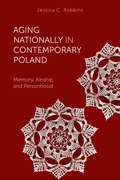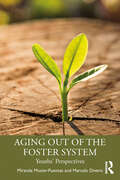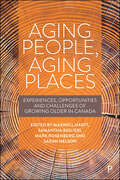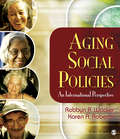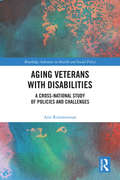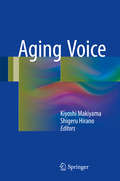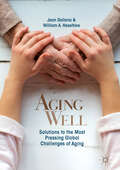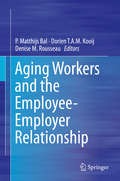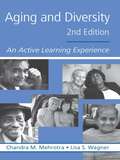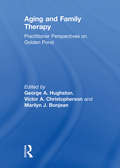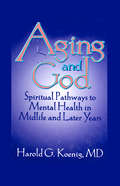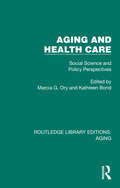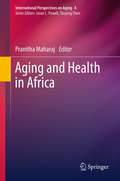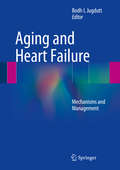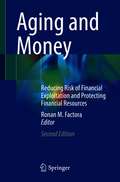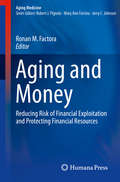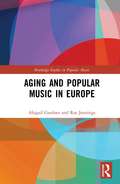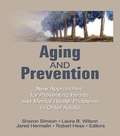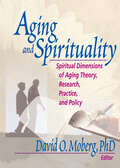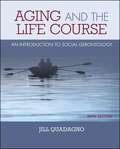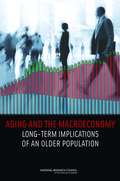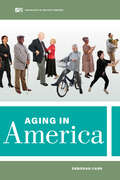- Table View
- List View
Aging Nationally in Contemporary Poland: Memory, Kinship, and Personhood (Global Perspectives on Aging)
by Jessica C. RobbinsActive aging programs that encourage older adults to practice health-promoting behaviors are proliferating worldwide. In Poland, the meanings and ideals of these programs have become caught up in the sociocultural and political-economic changes that have occurred during the lifetimes of the oldest generations—most visibly, the transition from socialism to capitalism. Yet practices of active aging resonate with older forms of activity in late life in ways that exceed these narratives of progress. Moreover, some older Poles come to live valued, meaningful lives in old age despite threats to respect and dignity posed by illness and debility. Through intimate portrayals of a wide range of experiences of aging in Poland, Jessica C. Robbins shows that everyday practices of remembering and relatedness shape how older Poles come to be seen by themselves and by others as living worthy, valued lives. In Aging Nationally in Contemporary Poland, we see how memories and understandings of the Polish nation intersect with ideals and experiences of late life to produce forms of life that are not reducible to binary categories of health or illness, independence or dependence, or socialism or capitalism.
Aging Out of the Foster System: Youths' Perspectives
by Marcelo Diversi Miranda Mosier-PuentesDecades of demographic studies and applied efforts have convinced scholars, students, and social workers that young people coming of age and transitioning out of the foster care system face great challenges in health, education, income, and general well-being. Despite the wealth of research on these outcomes, we know much less about the lived experiences of young people leaving foster care.Aging Out of the Foster System: Youths' Perspectives adds to this narrative the personal experiences of young people who are aging out or have aged out of their child welfare placement. The authors center the stories of these young people and apply critical ethnographic methods to frame their accounts with attention to the encounters within which they were produced, including power imbalances, institutional contexts, and relational dynamics.By centering the experiences of youths in these contexts and attending to the larger forces at work, this book helps connect the dots between youth aging out of the foster care system, social workers in Independent Living Programs, and the professors and scholars teaching the next generations of professionals working to support the aging out process.
Aging People, Aging Places: Experiences, Opportunities, and Challenges of Growing Older in Canada
by Maxwell Hartt, Samantha Biglieri, Mark W. Rosenberg & Sarah E. NelsonHow well do the places where we live support the wellbeing of older adults? The Canadian population is growing older and is reshaping the nation’s economic, social and cultural future. However, the built and social environments of many communities, neighbourhoods and cities have not been designed to help Canadians age well. Bringing together academic research, practitioner reflections and personal narratives from older adults across Canada, this cutting-edge text provides a rare spotlight on the local implications of aging in Canadian cities and communities. It explores employment, housing, transportation, cultural safety, health, planning and more, to provide a wide-ranging and comprehensive discussion of how to build supportive communities for Canadians of all ages.
Aging Social Policies: An International Perspective
by Professor Robbyn R. Wacker Dr Karen A. RobertoDue to population explosion and a global increase in average life expectancies, an unprecedentedly high percentage of the world's population is aging. By the middle of this century there will be up to 2 billion individuals over the age of 65, a demographic shift never before experienced in our human history. In addition, declining birth rates in industrialized countries means a decrease in the number of adults under 64. In Aging Social Policies: An International Perspective the authors consider how policy – domestic and international – affects and will continue to affect the lives of our aging population.
Aging Veterans with Disabilities: A Cross-National Study of Policies and Challenges
by Arie RimmermanThe number of older war veterans receiving disability benefits is steadily growing and is predicted to rise in the next decade. This book provides comprehensive knowledge about health and psychosocial concerns of veterans aging with disabilities and unmet needs and compares policy in three countries that have been involved in massive warfare in the 20th century––the United Kingdom (UK), the United States (US), and Israel. Using a cross-national comparative study of the policies, legislation and services provided by these three countries, which have significant numbers of aging disabled military veterans, this book provides evidence-based knowledge on the trajectories and attendant mental-health and psychosocial problems this sub-group faces when aging with a disability. It sheds light on the paradox in which most veterans with disabilities in the UK, USA and Israel are older, while the current legislation and budget target younger veterans with disabilities. The book reflects the current debate regarding the desired policy toward older veterans with disabilities in these countries and whether to provide them with proactive health services prior to retirement to prevent "accelerated aging". It also evaluates the dilemma of whether to serve aging veterans separately as a unique population or to provide them with the same services used by the general population. This book will be of interest to all academics and students working in disability studies, rehabilitation studies, gerontology, psychology, sociology, social work, social policy, and law more broadly.
Aging Voice
by Kiyoshi Makiyama Shigeru HiranoThis book discusses the aging voice, one of the interesting issues related to aging. Population aging is an issue in most developed countries, where both physicians and specialists are required to improve clinical and scientific practice for elderly adults. In particular, the need for expertise in the diagnosis and treatment of aging voice pathologies is increasing continually. New developments in regenerative medicine have taken care for the aging voice to new level, and the contributors to this book use their wealth of experience in the field of the aging voice to present the latest advances in this field. This book is a unique resource, providing new perspectives for physicians, clinicians and health care workers who are interested in the aging voice.
Aging Well: Solutions to the Most Pressing Global Challenges of Aging
by William A. Haseltine Jean GalianaThis open access book outlines the challenges of supporting the health and wellbeing of older adults around the world and offers examples of solutions designed by stakeholders, healthcare providers, and public, private and nonprofit organizations in the United States. The solutions presented address challenges including: providing person-centered long-term care, making palliative care accessible in all healthcare settings and the home, enabling aging-in-place, financing long-term care, improving care coordination and access to care, delivering hospital-level and emergency care in the home and retirement community settings, merging health and social care, supporting people living with dementia and their caregivers, creating communities and employment opportunities that are accessible and welcoming to those of all ages and abilities, and combating the stigma of aging. The innovative programs of support and care in Aging Well serve as models of excellence that, when put into action, move health spending toward a sustainable path and greatly contribute to the well-being of older adults.
Aging Workers and the Employee-Employer Relationship
by Denise M. Rousseau P. Matthijs Bal Dorien T.A.M. KooijThis book focuses on the aging workforce from the employment relationship perspective. This innovative book specifically focuses on how organizations can ensure their aging workers remain motivated, productive and healthy. In 15 chapters, several experts on this topic describe how organizations through effective human resource management can ensure that workers are able to continue working at higher age. In addition, this book discusses the role older workers themselves play in continuing work at higher age. To do this, the authors integrate research from different areas, such as literature on leadership, psychological contracts and diversity with literature on the aging workforce. Through this integration this book provides innovative ways for organizations and workers to maintain productivity, motivation and health. Aging Workers and the Employee-Employer Relationship summarizes the latest research on how employment relationships change with age and its implications for supporting the well-being, motivation and productivity of older workers. It identifies ways to improve how both companies and workers solve the problems they face. These include better designed employment practices and more adaptive job content and developmental opportunities for aging workers along with activities aging workers can engage to enhance their own job crafting, learning and employability.
Aging and Developmental Disability: Current Research, Programming, and Practice Implications
by Joy Hammel Susan NochajskiAging and Developmental Disability: Current Research, Programming, and Practice Implications explores research findings and their implications for practice in relation to normative and disability-related aging experiences and issues. This valuable book discusses the effectiveness of specific interventions targeted toward aging adults with developmental disabilities such as Down's Syndrome, cerebral palsy, autism, and epilepsy, and offers suggestions for practice and future research in this area.
Aging and Diversity
by Stephen Fried Lisa S. Wagner Chandra M. MehrotraThis new edition has been completely rewritten and includes chapters that address key topics in diversity and aging: research methods, psychological aging; health beliefs, behaviors, and services; health disparities; informal and formal care for older persons; work and retirement; religious affiliation and spirituality; and death, dying, and bereavement. Taking a broad view of diversity, Mehrotra and Wagner discuss elements of diversity such as gender, race or ethnicity, religious affiliation, social class, rural-urban community location and sexual orientation. Including these elements allows them to convey some of the rich complexities of our diverse culture - complexities that provide both challenges to meet the needs of diverse population and opportunities to learn how to live in a pluralistic society. Throughout the book, Mehrotra and Wagner present up-to-date knowledge and scholarship in a way that engages readers in active learning. Rather than simply transmitting information, the authors place ongoing emphasis on developing readers' knowledge and skills; fostering higher order thinking and encouraging exploration of personal values and attitudes. Distinctive features of the book include: Opening vignettes for each chapter that present a sampling of how the issues to be discussed apply to diverse elders. Active learning experiences that invite readers to interview diverse elders, conduct internet searches, and give an analysis of a case study. Quizzes at the end of the chapters help readers ascertain the extent to which they have learned the material; the key for each quiz includes details about correct and incorrect responses so that additional learning can occur. Aging and Diversity Online boxes interspersed throughout the book provide internet resources that readers may use to find new research and publications. Suggested readings and audiovisual resources given at the end of each chapter serve as a guide to additional information on topics covered in the chapter. This approach of presenting the material will help the readers understand and apply key concepts and principles in ways that will not only improve the lives of older people they serve, but will also enhance their own aging experience.
Aging and Family Therapy: Practitioner Perspectives on Golden Pond
by George Hughston Victor Christopherson Marilyn BojeanEnhance the intervention strategies you use in therapy with older adults and their families. This significant new book provides practitioners with information, insight, reference sources, and other valuable tools that will contribute to more effective intervention with the elderly and their families. Outstanding scholars have contributed original material that addresses the major issues in treating the elderly from the practitioner’s point of view; the biological, psychological, social, and spiritual concerns of the aged are examined in order to formulate a systemic and comprehensive treatment plan. Destined to become a classic in a challenging new area of psychotherapy, the unique Aging and Family Therapy promises to guide and inform practitioners who will be called upon to provide assistance to the increasing number of older adults who will be in need of mental health services.
Aging and God: Spiritual Pathways to Mental Health in Midlife and Later Years
by William M Clements Harold G KoenigThis important book examines the relationship between religion and mental health throughout the life cycle, with a special emphasis on later life. It asserts that successful aging is possible regardless of physical health or environmental circumstances, and that religious beliefs and behaviors may facilitate successful aging. Aging and God thoroughly examines the effects of religion and mental health on aging and provides a centralized resource of up-to-date references of research in the field. It focuses on recent findings, theoretical issues, and implications for clinical practice and contains ideas for further research. In Aging and God, you’ll also find information on project design that can help you develop grant applications and carry out studies.Aging and God is a helpful book for both mental health and religious professionals. It helps mental health specialists better understand the spiritual needs of older adults and the impact that religion can have on facilitating mental health. It also describes how religion can be utilized in clinical practice and integrated into psychotherapeutic approaches to older patients. The book brings religious professionals current knowledge of the major psychological problems that older adults face and how religion can be used to help alleviate these problems.Full of pertinent information, Aging and God addresses theoretical aspects of human development, focusing on cognitive, moral, and religious faith development examines situations and disorders of particular concern to older persons and looks at how religion can be used as a resource applies research findings to the problem of meeting the spiritual and mental health needs of elders with chronic or acute health problems provides an in-depth look at end-of-life issues such as physician-assisted suicideHospital and nursing home chaplains will find this book informative and encouraging, as will gerontologists, hospital administrators, and community clergy faced with increasingly older congregations. It gives mental health professionals new strategies to help improve the later years of older adults, and makes an excellent text for courses on religion, mental health, and aging. Middle-aged and older adults, as well as their families, will also find Aging and God enjoyable and inspiring as they attempt to grapple with the myriad adjustment and coping problems associated with aging.
Aging and Health Care: Social Science and Policy Perspectives (Routledge Library Editions: Aging)
by Marcia G. Ory Kathleen BondOf all the problems associated with a rapidly growing aging population, health care demands top priority. Research on health care for older people requires an understanding of the basic principles of aging and its related social processes, while popular assumptions on the subject are often ill-informed and are based more on misconceptions about aging than on scientific knowledge.
Aging and Health in Africa (International Perspectives on Aging #4)
by Pranitha MaharajPopulation aging is a matter of global concern. It often occurs in tandem with changes in the health profile of the population. In Africa, many countries are already facing a high burden of communicable diseases. However, as more and more children survive childhood and move on to adult years and old age they are also more likely to experience health problems associated with the aging process. Population aging in Africa is occurring in the context of high levels of poverty, changing family structures, an immense disease burden, fragile health systems and weak or poorly managed government institutions. This book shows that aging is likely to lead to increased social and economic demands for the continent. However, most national governments in Africa have not begun to address the issue of how to respond effectively to the needs of the older population. This will require a better understanding of the socio-economic and demographic situation of the older population in Africa. This book fills the gaps that exist by exploring the social realities of population aging in Africa. It also focuses on the policy and programmatic responses, gaps and future challenges related to aging across the continent.
Aging and Heart Failure: Mechanisms and Management
by Bodh I. JugduttThis book synthesizes the major research advances in molecular, biochemical and translational aspects of aging and heart failure over the last four decades and addresses future directions in management and drug discovery. It presents clinical issues and molecular mechanisms related to heart failure, including the changing demographics in the aging population with heart failure; hypertension and prevention of diastolic heart failure in the aging population; polypharmacy and adverse drug reactions in the aging population with heart failure; changes in the heart that accompany advancing age from humans to molecules; aging-associated alterations in myocardial inflammation and fibrosis and aging-related changes in mitochondrial function and implications for heart failure therapy. The book succinctly summarizes the large volume of data on these key topics and highlights novel pathways that need to be explored. Featuring contributions from leading clinician-scientists, Aging and Heart Failure: Mechanisms and Management is an authoritative resource on the major clinical issues in heart failure therapy in the elderly for cardiologists, gerontologists and internists.
Aging and Human Nature: Perspectives from Philosophical, Theological, and Historical Anthropology (International Perspectives on Aging #25)
by Mark Schweda Michael Coors Claudia BozzaroThis book focuses on ageing as a topic of philosophical, theological, and historical anthropology. It provides a systematic inventory of fundamental theoretical questions and assumptions involved in the discussion of ageing and old age. What does it mean for human beings to grow old and become more vulnerable and dependent? How can we understand the manifestations of ageing and old age in the human body? How should we interpret the processes of change in the temporal course of a human life? What impact does old age have on the social dimensions of human existence? In order to tackle these questions, the volume brings together internationally distinguished scholars from the fields of philosophy, theology, cultural studies, social gerontology, and ageing studies. The collection of their original articles makes a twofold contribution to contemporary academic discourse. On one hand, it helps to clarify and deepen our understanding of ageing and old age by examining it from the fundamental point of view of philosophical, theological, and historical anthropology. At the same time, it also enhances and expands the discourses of philosophical, theological, and historical anthropology by systematically taking into account that human beings are essentially ageing creatures.
Aging and Money: Reducing Risk of Financial Exploitation and Protecting Financial Resources (Aging Medicine Ser.)
by Ronan M. FactoraThis book aims to disseminate and share knowledge about financial exploitation of elders with the purpose of protecting those individuals in our society who are most vulnerable to financial abuse and mistreatment. It instructs practicing clinicians in identification of risk factors, recognition of signs, and implementation of screening methods to protect their patients. This updated edition expands upon and advances the earlier text by including the most recent research and methods used to assess risk of financial exploitation, as well as updates in how the law approaches such cases. It also highlights ways in which community awareness can aid in identifying those most at risk, effectively protecting the elderly community, advocating for those victimized, and pursuing perpetrators to the fullest extent of the law. Professionals from law enforcement, medical clinics, financial institutions, and the legal field are now tasked with acting on suspected situations thanks to increasing recognition of financial abuse and mistreatment of an aging population. This book also guides professionals on how to discuss this information with potential victims. This second edition of Aging and Money expands the knowledge base to highlight the perspectives of different disciplines including professionals in medicine, law, the financial industry, and social services who play an important role in investigating and preventing financial abuse of the elderly.
Aging and Money: Reducing Risk of Financial Exploitation and Protecting Financial Resources (Aging Medicine)
by Ronan M. FactoraIncreasingly, we hear of more and more elders falling victim to financial exploitation. Although this form of elder abuse has been recognized for years, its incidence, prevalence, and impact on the common individual has been only more recently brought to the spotlight. Despite these circumstances, recognition of risk factors and indicators of financial exploitation are not widely disseminated. Additionally, once situations are identified and confronted, the knowledge of what to do next is lacking. These gaps are present within the medical community, law-enforcement, and the finance community - areas where opportunities for recognition and intervention are common. Our elders often have no idea of what to do when they see their own risk or when they fall victim. Aging and Money: Reducing Risk of Financial Exploitation and Protecting Financial Resources helps clinicians to integrate identification of such indicators of abuse into their geriatric assessment as well as guide them in performing an assessment of an individuals' financial decision making capacity when appropriate. Aging and Money: Reducing Risk of Financial Exploitation and Protecting Financial Resources is an essential new text that provides the practicing clinician with information on identifying risk factors and clinical clues associated with financial exploitation and how to incorporate these steps into their practice.
Aging and Popular Music in Europe (Routledge Studies in Popular Music)
by Abigail Gardner Ros JenningsOpening up the dialogue between popular music studies and aging studies, this book offers a major exploration of age and popular music across Europe. Using a variety of methods to illustrate how age within popular music is contingent and compelling, the volume explores how it provokes curation and devotion across a variety of sites and artists who record in several European languages, and genres including waltz music, electronica, pop, folk, rap, and the French ‘chanson.’ Visiting the many ways in which age is problematized, revered, and performed within Europe in relation to popular music, case studies analyze: French touring shows of popular music stars from the 1960s; André Rieu’s annual Vrijthof concerts in the Netherlands; Kraftwerk and Björk’s appearances at renowned art museums as curated objects; queer approaches to popular music space and time; British folk music inheritances; pan-European strategies of stardom and career longevity; and inheritance and post-colonial hauntings of race and identity. The book works with the notion of travelling, across borders, genres, sexualities, and media, highlighting the visibility of the aging body across a variety of European sites in order to establish popular music through the lens of age as a positive methodology with which to approach popular music cultures, and to offer a counter-narrative to age as decline. This book will appeal to scholars of popular music, popular culture, media studies, cultural studies, aging studies, and cultural gerontology.
Aging and Prevention: New Approaches for Preventing Health and Mental Health Problems in Older Adults
by Robert E HessRenowned specialists on aging explore the meaning of prevention and provide practical information about programs and services for the elderly. Interesting chapters focus on the prevention of long-term care institutionalization, alternative health delivery systems, informal support networks, and the prevention of domestic neglect and abuse of elderly adults.
Aging and Social Expenditure in the Major Industrial Countries, 1980-2025
by Peter S. Heller Richard Hemming Peter W. KohnertFinancial report from the IMF
Aging and Spirituality: Spiritual Dimensions of Aging Theory, Research, Practice, and Policy
by David O. MobergExplore the spiritual dimensions of aging through science, theory, and practice!During the later years of life, many people devote energy to a process of spiritual awakening and self-discovery. Yet their family, friends, clergy, and the helping professionals who work with them are not always prepared to understand or deal with the spiritual concerns of their clients. Aging and Spirituality provides a unique, far-reaching overview of this long-neglected field.Divided into four independent but interwoven sections, this landmark book covers the spiritual realm with scientific rigor and deep human understanding. Aging and Spirituality comprehensively surveys the issues of spirituality, from the groundwork of basic definitions to detailed assessments of the role spirituality plays in the lives of the elderly and suggested directions for further research. This book's unique approach combines scholarly research and practical nuts-and-bolts suggestions for service delivery. By drawing from many disciplines and professions, it offers fresh perspectives to even those practitioners already familiar with the most effective spiritual techniques their own field can offer. Aging and Spirituality answers such common questions as: What are the spiritual needs of people later in life? Is there any solid evidence that prayer changes things? How is spirituality related to physical and mental health? Does spirituality matter when people know they are dying? How can we measure spiritual wellness and assess the outcomes of activities intended to enhance it? Will attention to spirituality aggravate or alleviate the losses--of friends, family, health, youth--that so often occur during old age?Aging and Spirituality provides a much-needed resource for health care professionals, clergy, social workers, and counselors working with geriatric clients. By integrating spiritual issues into the theoretical framework of social gerontology, Aging and Spirituality will help you understand the scientific foundations, practical applications, and public policy implications of spirituality for older adults.
Aging and the Life Course: An Introduction to Social Gerontology (5th Edition)
by Jill QuadagnoAging and the Life Course is a comprehensive interdisciplinary text in social gerontology. It provides students with a firm grounding in methodological and theoretical issues associated with aging and examines changes in social roles, relationships and the biological and psychological process that occur as people grow older. It also considers all major life transitions including retirement, widowhood, grandparenting, and changes in living arrangements. In addition, this text considers the economic and political issues that influence the context in which people grow old. Although the primary focus is on the U. S. , considerable material on aging worldwide is included. Unique features include four featured boxes, a life course perspective and an emphasis on inequality by race, ethnicity and gender.
Aging and the Macroeconomy
by National Research Council Committee on Population Division on Engineering and Physical Sciences Division of Behavioral and Social Sciences and Education Board on Mathematical Sciences And Their Applications Committee on the Long-Run Macro-Economic Effects of the Aging U.S. PopulationThe United States is in the midst of a major demographic shift. In the coming decades, people aged 65 and over will make up an increasingly large percentage of the population: The ratio of people aged 65+ to people aged 20-64 will rise by 80%. This shift is happening for two reasons: people are living longer, and many couples are choosing to have fewer children and to have those children somewhat later in life. The resulting demographic shift will present the nation with economic challenges, both to absorb the costs and to leverage the benefits of an aging population. Aging and the Macroeconomy: Long-Term Implications of an Older Population presents the fundamental factors driving the aging of the U.S. population, as well as its societal implications and likely long-term macroeconomic effects in a global context. The report finds that, while population aging does not pose an insurmountable challenge to the nation, it is imperative that sensible policies are implemented soon to allow companies and households to respond. It offers four practical approaches for preparing resources to support the future consumption of households and for adapting to the new economic landscape.
Aging in America (Sociology in the Twenty-First Century #8)
by Deborah CarrThe aging of America will reshape how we live and will transform nearly every aspect of contemporary society. Renowned life course sociologist Deborah Carr provides a lively, nuanced, and timely portrait of aging in the United States. The US population is older than ever before, raising new challenges for families, caregivers, health care systems, and social programs like Social Security and Medicare. Organized in seven chapters, Aging in America covers these topics: the history of aging and the development of theoretical approacheshow cultural changes shape our views on agingthe demographic characteristics of older adults todayolder adults' family lives and social relationshipsthe health of older adults and social disparities in who gets sickhow public policies affect the well-being of older adults and their familieshow baby boomers, Gen Xers, and millennials will experience old age Drawing on state-of-the-art data, current events, and pop culture, this portrait of an aging population challenges outdated myths and vividly shows how future cohorts of older adults will differ from the generations before them.
